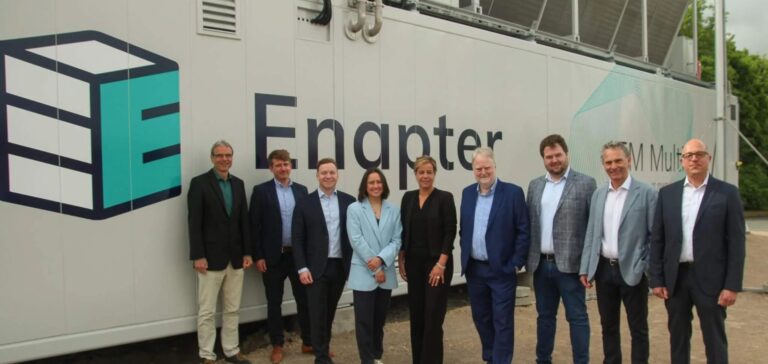Enapter AG today unveiled to the public the AEM Multicore – the world’s first megawatt class AEM electrolyzer for the production of green hydrogen. The megawatt electrolyser was officially unveiled in the presence of Mona Neubaur, Minister of Economic Affairs, Industry, Climate Action and Energy and Deputy Minister of North Rhine-Westphalia. With the AEM Multicore, Enapter is ushering in a new era in environmentally friendly solutions for the decarbonization of industry and the economy, and reaching a milestone in its corporate history.
The AEM Multicore is a cost-effective alternative to conventional megawatt class electrolysers. It is composed of 420 central modules, called “AEM stacks”. These cells are combined to form an overall system capable of producing approximately 450 kilograms of green hydrogen per day, with a purity of 99.999%. By consolidating many small units into one large system, Enapter can significantly reduce the cost of green hydrogen.
Very high demand for the AEM Multicolor
Enapter is already experiencing a very high demand for the Multicore AEM. Orders have already been received from Europe, Asia and North America. In 2023, Enapter will focus on building the first commercial AEM Multicore systems, while pre-production maturity is expected to be achieved starting in 2024. In the medium term, the megawatt electrolyser will be mass-produced at the Enapter campus, located in the German climate community of Saerbeck, North Rhine-Westphalia.
Production, research and development facilities as well as administrative offices are being created on the Enapter campus, which covers more than 80,000 square meters. The research and development team has already started its activities on site. The energy supply of the Enapter campus, including all future production facilities, is entirely covered by renewable energy. To achieve complete grid-independent energy autonomy, photovoltaic systems will be used on the Enapter campus, as well as green electricity from nearby solar, wind, and biomass plants in the Saerbeck Bioenergy Park. The waste heat from the Bioenergiepark biogas plants will be used to heat the buildings of the Enapter campus.






















